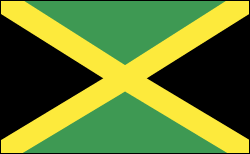Jamaica History


Pre-Columbian History
The earliest peoples of Jamaica are mostly known to us from the few artifacts they left on the island; they're most commonly known as the Redware people as a result. The most influential people on the island, who would inhabit it until the arrival of the Spanish in the late 1400s, were the Taíno. The Taíno are an Arawakan group who first came to Jamaica in the 800s C.E., bringing with them systems of government and farming that are common to a lot of other Arawakan parts of the Caribbean. The people settled in various autonomous communities run by caciques, with economic lives largely centered around agriculture. They planted maize and yuca to great effect; Taíno farmers used a system of control burns to enrich the soil, and would plant yuca in the ashes for better crop yields.
We know that Taíno culture incorporated substantial handicrafts woven from the island's plants, and that the people engaged in a popular regional sport called batéy. The batéy court was usually at the center of a settlement, and the game served many valuable cultural functions. We also know that the Taíno practiced matrilineal inheritance (property inherited from mother to daughter), as opposed to the patrilineal system more familiar to European cultures, and that they had nuanced family structures and traditions. Although the Taíno didn't have a written language, Arawak words from the local Taíno (from Jamaica and elsewhere) have had a profound impact on Spanish and English. Loan words from Arawak include barbecue, hammock, potato, and hurricane. The name Jamaica comes from the Taíno name for the island, Xaymaca.
Spanish Jamaica
Columbus explored it in 1494 and named it Santiago (St. James). In the early years of Spanish colonization, the island was largely overlooked. Colombus's family, who were given rights to the island by the Spanish Crown, mostly just used it as a resupply point for ships in the area. The colony proper wouldn't really begin until the founding of New Seville in 1509. The capital would be moved to Villa de la Vega (later called Spanish Town) in 1534.
As elsewhere in the colonized Americas, forced labor, colonial violence, and European disease took a major toll on the island's population. As the local Taíno died in large numbers, African slaves were shipped to the colony and forced to continue the grueling physical labor. Santiago lacked obvious mineral wealth (i.e. gold and silver), and so the colony was mostly used as a military forward outpost for colonizing other regions. The Santiago colony never reached substantial size or wealth compared to Cuba. At its peak, the colony reached nearly 3,000 people.
Under the British Empire
In 1655 it became a British possession. Buccaneers operated from Port Royal, also the capital, until it fell into the sea in an earthquake in 1692. Disease decimated the Arawaks, so black slaves were imported to work on the sugar plantations. During the 17th and 18th centuries the British were consistently harassed by the Maroons, armed bands of freed slaves roaming the countryside. Abolition of the slave trade (1807), emancipation of the slaves (1833), and a drop in sugar prices eventually led to a depression that resulted in an uprising in 1865. The following year Jamaica became a Crown colony, and conditions improved considerably. Introduction of bananas reduced dependence on sugar.
Independence
On May 5, 1953, Jamaica gained internal autonomy, and, in 1958, superheaded the organization of the West Indies Federation. A nationalist labor leader, Sir Alexander Bustamente, later campaigned to withdraw from the federation. After a referendum, Jamaica became independent on Aug. 6, 1962. Michael Manley, of the socialist People's National Party, became prime minister in 1972.







